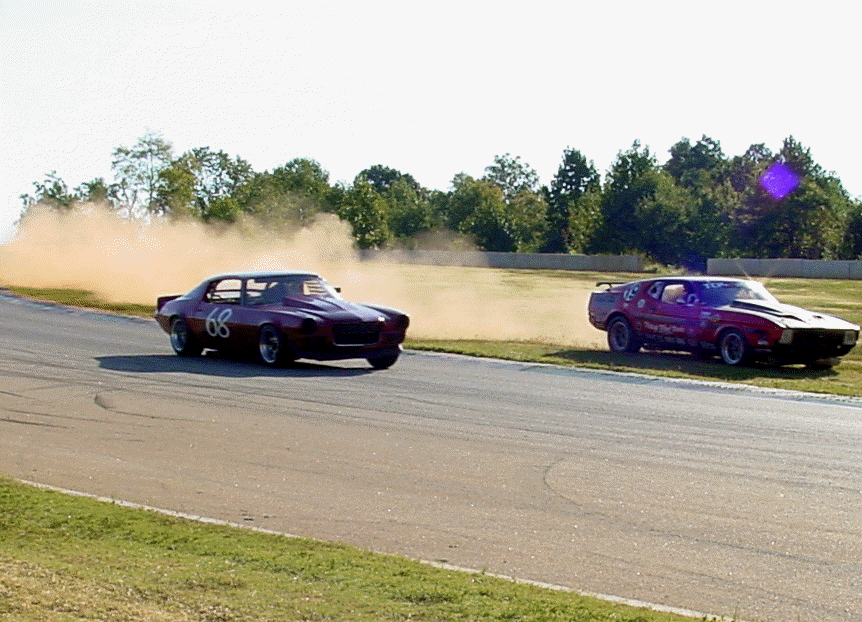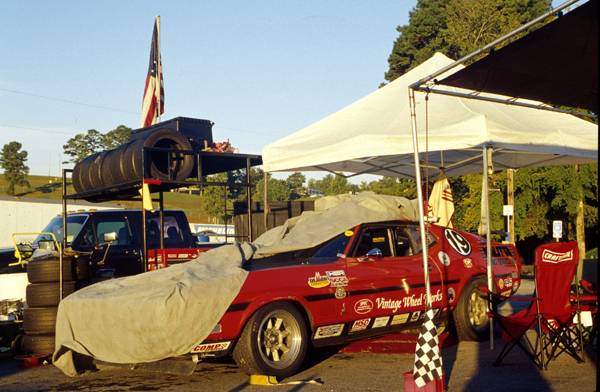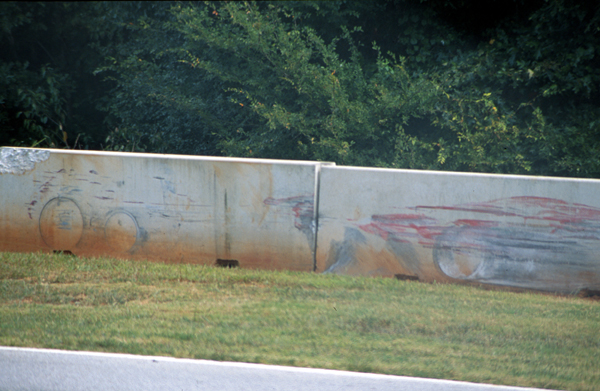
Fear and Loa
 |
Fear and Loa |
 Fear
and Loathing on the Vintage Racing Trail:
Fear
and Loathing on the Vintage Racing Trail:
Spinning And Winning
By Brion Gluck
www.darkhorseracing.net
It was a somber atmosphere at Road Atlanta for the 2001 Atlanta Historic races, with the race weekend beginning just two days after the New York and Washington terrorist attacks. Although for the teams and fans the races were a welcome, if brief, distraction from the events of the week, there were reminders of those events everywhere.
Reminders in the form of missing drivers, stranded around the country by grounded air traffic. Reminders in the hundreds of American flags seemingly everywhere at the track. And most of all, reminders in the shock, sadness, anger and determination in the faces of the people in attendance.
Prior to making the short drive from my home in LaGrange, Georgia, to the track, the Team Dark Horse 1971 Mach I got only a few upgrades from its last outing on the tri-oval at Charlotte. First on the list was a set of roller rockers from Comp Cams, followed by the installation of a Barry Grant Rush air filter. The engine felt quite a bit stronger and crisper with those upgrades.
Bob Woodward provided a set of Hoosiers and excellent advice on tire pressures for Road Atlanta, both of which were of great help.
For the race I had a little more assistance than I usually do, with Lenny Cotto of Granger Industrial Supplies driving in from Knoxville, Tenn., to help out, and Cam Lummus assuming his usual role as crew chief Saturday.
In the first practice Friday morning, the Mach I was turning 1:49 to 1:50 laps, which was about mid-pack for group 8. Fayetteville, Georgia's Craig Sagon, driving a very quick 1968 Camaro, was turning very low 1:40s to lead the group. Sagon's car was so fast, legends about it were springing up like mushrooms in the pits. "It's all fiberglass." "It's got a Winston Cup motor in it." "It only weighs 1,800 pounds." Fortunately, he doesn't run in my class, and is usually far enough in front that he might as well be in a different group, as well.
I was the third fastest Mustang in practice, behind Craig Ross in his yellow 1970 Boss, who was a bit off-pace due to suspension and tire problems that relegated him to 10th fastest overall in practice.
By the afternoon practice, I was turning consistent 1:47 laps, but began noticing on the long back straightaway some tire smoke from the rear coming into the car. It wasn't much, and I finished the run without incident and put the car up for the night.
Saturday morning, there was so much tire smoke on the straights that it looked like Mount Vesuvius erupting. Not good, and it's nasty stuff to try and breathe to boot. Pitting to investigate, we could see that on the driver's side rear tire, there was barely a fingers-width of room between the tire and the wheel arch. On the passenger side, you could stick your whole fist behind the wheel. Clearly, we had a severe rear-end problem.
The leaf spring locator pins, which attach the springs to the axle, had snapped on both sides, probably from the heavy suspension loading on the high bank at Charlotte's tri-oval in the last race. This let the axle start wiggling backwards, until the left side had moved three inches back, stopped only by the tire hitting the wheel well.
Amazingly enough, although the car had been driving sideways most of Friday's practice, I hadn't really noticed what was going on, and the tire smoke didn't start until speeds were well over 130 mph on the straights. I'm a pilot, and I'm so used to keeping a plane flying straight into a crosswind by cranking the yoke over that I must have automatically just kept dialing in more steering input to keep the car straight without even thinking about it. Funny in retrospect, but I felt pretty stupid for not noticing it earlier.
To replace the pins, we had to take the leaf springs completely apart and re-center them to put the pins back in and reassemble the rear end. This took three hours or so, and we got the car put back together just in time for the WorldCom Dash qualifying race in the afternoon.
Not surprisingly, in the qualifying race the car now tracked straight and was much more nimble. It was willing to turn both right and left now, and the lap times, even in traffic, were now down in the 1:45s, a marked improvement.
I was gridded about mid-pack for the qualifier, next to the Sunbeam Tiger of John Sybrandt. The Tiger got a tremendous launch on the rolling start and split the pack right up the middle. I tucked in behind him, and we both had picked off a pair of Porsche RSRs by the time we hit Turn 1.
Sybrandt and I were pretty even matched, but I managed to get by him on the third lap and started to reel in the field ahead. Another pair of Porsches fell to Ford power on the long straightaway, and I found Gary Jones in his 1965 Mustang ahead of me.
Jones and I battled for several laps. He was lighter and could go deeper into the corners, had nearly as much horsepower as me, and was a past series champion in the car. Finally, I got a good drive out of Turn 7 onto the long straight and was right on the 65's bumper as we braked hard for the chicane. We got so close, I found out afterward, that corner workers were sure we had bumped; if it hadn't been for some excellent driving by Gary, we well might have.
I was able to take the inside line on Turn 10 to nose past him, bumping over the rumble strip on the edge, downshifting all the way to second gear to get a hard launch out of the corner, and then just keeping my foot planted to keep Jones behind me. He was breathing down my neck the remainder of the qualifier, but I managed to hold him off.
All the while we were dicing, we were both picking off other cars and moving through traffic, including catching Porsches in turns, which is almost unheard of. The close racing had our adrenaline pumping, and we were both driving our cars to the limit.
With just an hour between the qualifier and the Rolex GT Endurance Challenge race, we had little time to do more than refuel and check the tire pressure and temperatures. Once again I was gridded next to Sybrandt's Sunbeam, but this time we were both at the back of the pack because of all the faster cars running in the 60-minute endurance race.
This time, I beat the Tiger to the punch on the green flag, splitting the Sunbeam and a blue Porsche 914-6, and then almost immediately blew past a yellow 914 to slot in behind an RSR entering Turn 1.
With the pack still bunched together from the start, I had to wait until the long straightaway to finally dispatch the wide-body Porsche. I'd picked up four positions in less than a lap, and was feeling pretty good about myself.
Just as I'd done in the qualifier, though, the Tiger was behind me like a running back following a lead block and slipped past as I ran up on a Corvette. The Corvette, the Tiger and I fought a nasty 3-car dogfight for a lap or two, with Sybrandt getting seriously loose in the Sunbeam trying to stay in front. We could go down the straights neck and neck, but the much lighter Tiger would outbrake me into the turns and I just couldn't get by.
Finally, I got past him coming out of Turn 12 under the bridge, getting some air over the bump that marks the steep downhill section around to the front straight.
Ahead was Gary Jones in another of his Mustangs, a gold and black '65 notchback. With the Tiger out of the way, I quickly ran the '65 down and passed it on the inside in Turn 1 on the next lap.
The other cars in the group were way, way ahead, so I had an open track in front of me for several laps, until I eventually came up on a blue RSR and made the mistake of trying to follow his line through Turn 2.
I went in too deep, missed a shift, and went completely agricultural, all four wheels into the grass. My new air dam, not exactly designed for use as a plow, was folded all the way back. Never lifting, I kept rolling through the grass and back onto the track at Turn 3.
The RSR went right by me, as did Jones a few moments later in Turn 6. I was concentrating on assessing how much damage the off-road excursion had done, as the cockpit was full of grass making baby tornadoes and big puffs of Georgia red clay were flying up whenever I touched the brakes. The air dam is making interesting scraping noises.
A good time for the mandatory five-minute pit stop, I thought, even if it was a little early in the race. While Lenny was refueling, Cam and I ripped the destroyed air dam off the front of the car. It ended up being an over eight minute stop, and I was anxious to get back on the track and start making up for lost time.
It turned out that the new larger air dam we'd installed for Road Atlanta was much too large, and we were better off without it. The car was a great deal faster on the straights now, perhaps a good 10 mph or more.
I passed Sybrandt and Jones again, but at this point I had no idea how many laps down or up I was, since I didn't know for how long or even if they'd pitted yet. Real racing isn't like video games, unfortunately, with helpful displays letting you know exactly what place you are in and how far you are behind everybody else. Sometimes in amateur endurance racing you lose track of where you are in relation to the other teams almost completely, particularly if you can't dedicate a team member to counting other cars' laps. (Even professional racing isn't immune to confusion; witness the first IRL race at Texas Motor Speedway a few years ago where botched lap counting led to A.J. Foyt and Arie Luyendyk getting into a fistfight in the winner's circle.)
The extra straightaway speed let me reel in cars by the bunches, even the very quick BMW CSL that finished fifth overall, but it wasn't until the race ended that I found that I'd finished first in my class and 17th overall, with a best lap of 1:45.9 over 25 circuits. If it hadn't been for the off-road excursion, I might have had a top 10 finish.
Eric Bretzel, in 3.0 Porsche 911 was first overall with a best lap of 1:36, completing 32 laps in the hour, followed by Larry Ligas in an E-type Jaguar and Bryan Berry in a 911 Turbo.
While we were happy to have taken the class win, the team got
a sobering reminder of what was really important. Lenny had to leave for New
York to help in the rescue efforts, leaving Cam and I to prep the car for the
sprint race early Sunday morning.
At the end of the endurance race, I'd been fighting overheating brakes, having to double-, triple- and sometimes quadruple-pump them to get the pressure up. Now that both the car and I are much quicker, the brakes are being pushed hard enough that fluid was beginning to boil in the calipers. A recirculator, essentially a brake fluid pump, looks like the next mechanical upgrade the car will need.
Cam and I spent a couple of hours replacing the air dam, putting on a set of fresh Hoosiers, changing the oil, and checking nuts and bolts. By the time we were done it was 10 p.m., and we decided to skip bleeding the brakes, instead just topping off the fluid.
Within the first lap of the WorldCom Dash race Sunday morning, I knew I was in real trouble with the brakes. The first time I went hard into turn 10, I was already double-pumping to make the stop, and I knew it would only get worse as the race went on.
There was nothing to do but adjust the brake bias as far to the rear as I could, and try to take it easy on them, as easy as I could and still be racing, that is. On any given lap, I would have virtually no braking at all from Turn 1 through Turn 6. From Turn 6 to Turn 10, there was just enough stopping power, with help from some extremely precise downshifting, to be able to make the turns. And then it was back to no binders again until I came back around.
For five laps, I managed to piece things together enough to work my way up through the pack a bit, until I found myself behind Jones, now back in his blue '65 fastback, as we flew down into Turn 10, a place where I'd outbraked him for a pass in the endurance race the previous day.
This time, I pranged the downshift to third and got none of the deceleration I needed from engine braking. I jabbed at the brakes, but there was nothing there at all, and I went flying off the track into the gravel trap.
The car spun one-and-a-half times, ending up facing backwards, but still rolling. I managed to get the engine started and did my best Junior Johnson-style bootlegger turn to get turned around and back on the track at the bridge.
With gravel still being scraped off the tires as I got back up to speed, race leader Sagon's Camaro came flying up behind me. I gave him the hand signal to pass me on the left, but he didn't see it and went to the right. Caught in a squeeze at the corner, I went off the track into the grass again, at the same spot I had in the endurance race.
At 9 a.m., the grass was heavy with dew and as slick as ice. I
tried to coax the car gently back onto the track as I slid forward, still going
80 mph or so. Unfortunately, it was a rear tire that ended up on the track
first, and it immediately pulled the rear end out. The car shot sideways across
the grass and broad sided the wall 40 yards away, leaving a pair of black
doughnuts with a swash of red paint between them painted on the concrete.
The impact smashed the front fender, driver's door and rear quarter panel. The front suspension was mangled, although the Vintage Wheelworks wheels were only scratched, not bent. Back in the trunk, the battery hold-down brackets snapped at the welds, sending the battery flying out of its mount.
The grass was so slippery that it took another 10 seconds or so for the car to stop sliding forward after hitting the wall, even with the crumpled coilover. The Mach I finally came to a stop just past Turn 4, where I watched the remainder of the race.
What will need to be done to get the car back on the track for Daytona, if not in November, then in February for the start of the season? Obviously, a lot of bodywork is in the cards.